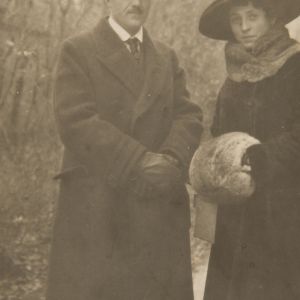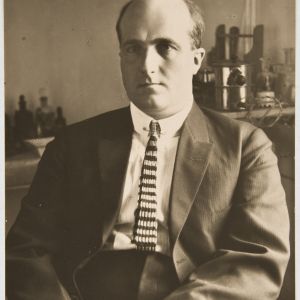Timotei Cipariu Street no.1
Built at the beginning of the XX century, under the guidance of pastor Mihály Szabolcska, the Reformed Church is today among the most beautiful and monumental buildings of the Elisabeth neighborhood.
Listen to the audio version.
The Reformed Church,located on the corner between Timotei Cipariu Street and 16 Decembrie 1989 Blvd., is today one of the most beautiful and monumental buildings of the Elisabetin.
The church project was designed by architects Károly Nagy jr. and László Jánosházy from Budapest, architects and professors of the Budapest Polytechnic, and the execution was entrusted to the Timisoara-based builder Karl Hart, under the guidance of pastor Mihály Szabolcska. The foundation and masonry works were started on August 1, 1901. The building was festively inaugurated on October 19, 1902, being a two-story building and serving the Reformed religious community. The prayer room has 250 square meters, with 312 seats in benches for parishioners and another 47 seats on the upper level, for cantor and choristers. Along with the standing places, the church could hold about 500 people. The organ was made in Leopold Wegenstein's workshop, and the solid oak pulpit, pews and furniture are the product of Jakab Fischer's workshop in Timişoara. The building, according to the original design, included the prayer room, the parish office, the pastor's and the chaplain's dwelling, as well as the private dwellings and commercial premises that were to provide a decent and permanent income to the congregation. Since 1996, there have been two bells in the tower of the building: a smaller one, weighing 120 kilograms and a large one, weighing 150 kilograms.
In front of this building, the parishioners of the parish gathered on December 15, 1989, to oppose the evacuation of Pastor László Tőkés, and a day later, on December 16, the Revolution in Timișoara started, which led finally to the removal of the communist dictatorship from Romania.
On the left wall of the entrance to the building, on Timotei Cipariu Street, were placed two marble slabs that evoke, in the four traditional languages in Banat (Romanian and Serbian / Hungarian and German), the event of December 1989: “From here started the Revolution / which abolished the dictatorship / 15.XII.1989 ”. On the right side of the entrance, there is a commemorative plaque dedicated to the pastor and poet Mihály Szabolcska.
Architecturally, the building is built in the style of the 1900s, an eclectic style with neo-GothicIts volumetry relates very well to the two neighboring intersections, punctuating them through two towers (characteristic attitude of the city of Timisoara), different in size and height. The facades of the building are divided into five unequal registers, corresponding to each level. Register I, corresponding to the basement, is simple and without decoration. Register II, corresponding to the high ground floor, is distinguished by a treatment that imitates a parament. The following two registers (floor I and floor II) present the most decorative elements: apparent brick appearance, marking of the window frames, ogival arches, horizontal belts, and the rhythmic cornice of simple consoles. Register V corresponds to the gabled roof in the area of the towers.
Bibliography:
- Deselega Gyula, Ghidul Timișoarei, Diaspora FoundationTimisoara, 2011, pp. 167-168.
- János Szekernyés, Evocative signs of Hungarianness in BanatTimisoara, 2013, pp. 593-599.
- Josef Geml, Old Timisoara in the last half century 1870-1920Cosmopolitan Art Publishing House, Timisoara, 2016, pp. 117.
- Opriș Mihai, Botescu Mihai, Mihai, Historic architecture in TimișoaraPrinted by S.C. Tempus S.R.L, Timisoara, 2014, ISBN 978-973-1958-28-6.
- https://adevarul.ro/locale/timisoara/foto-povestea-bisericii-reformate-piata-maria-locul-sa-aprins-revolutia-anticomunista-1989-1_5a32e72a5ab6550cb833c3d9/index.html - site accessed on March 15, 2020
Listen to the audio version.
Pia Brînzeu, Family Journal, Manuscript
Stop 2: The Reformed Church on Timotei Cipariu Street
December 16, 1989. It’s Saturday morning. I am called to a department meeting to welcome the American lecturer who has arrived in Timișoara unexpectedly. I’m grumbling to myself, wondering why she had to come just now, right before the holidays, and not at the beginning of October, as it would have been normal. I pass by Tökes’ house, where there is a handful of people and twice as many police. “Someone must have stolen something again”, I tell myself, still sulking.
I am invited to dinner in the evening. A friend and her husband have offered to pick me up. I stand waiting for half an hour in front of the house. No sign of them. “It seems like everything is going wrong for me today,” I remark, grumpy and looking at the two young men who are also waiting, leaning on a Dacia, in front of my gate. They wear new leather jackets and good sneakers, and are smoking Kent cigarettes. What are these two doing right outside my house? A quarter of an hour later, my friend comes running, confused.
“They wouldn’t let us pass in the car”, she says, “because they claim there is a riot on your street, but I don’t see anything. They also mentioned an overturned bus, have you seen anything?”
“I don’t know anything, it’s peace and quiet”, I reply and we both run to the car.
We come back around midnight. Somebody stops us at the corner, warning us not to go on our street because five young men, all wearing new leather jackets and good sneakers, are smashing with iron crowbars the windscreens of the cars driving by. I recognize the two with whom I had exchanged inquiring glances a few hours earlier. My parents stay hidden behind the blinds and are watching the brutal show in the street in despair, thinking I had taken my car and I would become the victim of these rioters. They’re happy to see me back safe. The show goes on until after 2 am. Then the young men walk towards the bookshop on the corner, they break the window, and start burning the books. “Where books are burning, people will also be dying”, my mother mutters scared, thinking about the Second World War. Then the windows of the shops lined up along the tramline are smashed. Soon they will overturn a bus that has come out of nowhere, driving empty, at random, in the middle of the night.
Because of the racket, we only go to sleep at dawn. It’s been an agitated and unexplainable night. Who were the five young men? They were not hooligans, they were too well dressed. Why were they breaking the windscreens of cars just driving by? Why didn’t the police intervene, dozens of whom were there, in the neighbourhood, in the morning, yet not one showed up now?
“Ever since they elected a Polish Pope, things tend to happen differently than you would expect”, my father chimes in wisely.
In the morning I go with my son to see what’s going on. Each broken window is replaced with one of the right size. Did they have them all ready? Right on a Sunday morning?
Later, looking back on all these memories and with the wisdom of hindsight, I would understand. The mystery of such a moment can be compared to a palimpsest. Beyond the immediately visible, there are other things which history would reveal only later on. Scraping off the writing, you unveil a show which can only be understood partially when it is happening. You only have one part of the prism available, only one facet of the truth, and the inevitable perplexities can be solved only when you are allowed to piece things together. All you can do is accept the fact that the unknown and the invisible always surround you in life, overwhelming you especially when the big history is written. And the big history, I believe, is always written by somebody, not improvised, it is always directed and not spontaneous, even if unpredicted elements may often appear. But what is individual destiny then? A role you take on in a world where you are not the only director, but you also depend on those who overturn history, together, maybe, with those from the world beyond? And how can you possibly know beforehand whether the space of history, opened by others for you will take you to an altar or a scaffold?












